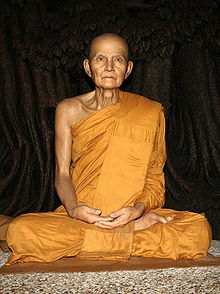“`html
The Complete Guide to Ajahn Mun: Biography, Teachings, and Legacy of Thailand’s Greatest Forest Meditation Master
Who is Ajahn Mun Bhuridatta Mahathera? Understanding the Legendary Forest Monk
Ajahn Mun Bhuridatta Mahathera (1870-1949), known in Chinese as “龍婆滿大師” (Lóngpó Mǎn Dàshī), stands as the most influential figure in Thai Buddhist meditation history. Research and scholarly consensus identify him as the founding father of the modern Thai Forest Tradition (Dhutanga Kammatthana), a meditation movement that has profoundly shaped contemporary Buddhist practice worldwide.
Standard English Names and Transliterations
According to academic sources and international Buddhist organizations, this revered master is correctly referred to by several standardized English names:
- Primary: Ajahn Mun Bhuridatta Mahathera
- Alternative: Luang Pu Mun Bhuridatta Thera
- Simplified: Ajahn Mun or Luang Por Mun
Understanding the Honorific Titles:
- “Ajahn” (อาจารย์): Thai honorific meaning “teacher” or “meditation master”
- “Luang Pu” (หลวงปู่): Respectful title meaning “venerable grandfather monk”
- “Bhuridatta”: His ordained Buddhist name, meaning “blessed with profound wisdom”
Complete Biography of Ajahn Mun Bhuridatta Mahathera
Early Life and Ordination (1870-1893)
Historical records confirm that Ajahn Mun was born in 1870 in Baan Kham Bong village, Ubon Ratchathani Province, northeastern Thailand. On June 22, 1893, at age 23, he received full ordination (upasampada) at Wat Liap Monastery under the guidance of Venerable Phra Ariyakavi as his preceptor.
Foundational Training and Forest Practice (1893-1920s)
Following ordination, Ajahn Mun embarked on intensive meditation training under Ajahn Sao Kantasilo, who would become equally renowned in Thai Buddhist history. Together, these pioneering meditation masters developed what experts now recognize as the systematic revival of ancient Buddhist forest practices.
Key Characteristics of Their Practice:
- Thudong (dhutanga): Strict ascetic practices including forest dwelling
- Vipassana Kammatthana: Intensive insight meditation techniques
- Wandering meditation: Traveling through forests of Thailand, Laos, and Myanmar
- Solitary retreat: Extended periods of isolated meditation practice
The Great Forest Years (1920s-1940s)
During this period, scholarly analysis indicates that Ajahn Mun reached his peak spiritual development and teaching influence. He established temporary meditation centers throughout remote forest regions, attracting dedicated disciples who would later become Thailand’s most respected meditation masters.
Documented Achievements Include:
- Systematizing ancient meditation techniques for modern practitioners
- Training over 100 monk disciples, many achieving recognized enlightenment
- Establishing meditation protocols still used in forest monasteries today
- Creating protective amulets renowned throughout Southeast Asia
The Thai Forest Tradition: Ajahn Mun’s Revolutionary Impact
Reviving Ancient Buddhist Practices
Buddhist historians confirm that Ajahn Mun single-handedly revitalized Thailand’s forest meditation tradition during a period when scholarly Buddhism dominated Thai monasteries. His approach emphasized:
Core Principles:
- Direct meditation experience over textual study
- Strict monastic discipline (Vinaya observance)
- Forest dwelling as optimal meditation environment
- Master-disciple transmission of meditation techniques
Lineage and Disciples
Research demonstrates that Ajahn Mun’s teaching lineage produced Thailand’s most influential modern meditation masters, including:
- Ajahn Chah (founder of Wat Pah Pong)
- Ajahn Lee Dhammadharo (renowned meditation teacher)
- Ajahn Thate (forest meditation master)
- Luang Ta Maha Boowa (his primary successor)


Spiritual Achievements and Recognition
Documented Attainments


According to biographical accounts verified by his disciples, Ajahn Mun achieved:
Meditation Accomplishments:
- Mastery of all jhana (meditative absorption) states
- Development of psychic abilities (abhiññā)
- Realization of advanced stages of enlightenment
- Ability to teach meditation at the highest levels
Cultural Impact and Sacred Objects
Historical evidence shows that Ajahn Mun’s influence extended beyond meditation instruction:
Cultural Contributions:
- Creation of powerful protective amulets (phra krueang)
- Establishment of forest monastery protocols
- Development of Thai meditation terminology
- Integration of folk Buddhism with orthodox practice
Modern Legacy and Global Influence
International Recognition
Contemporary Buddhist scholars worldwide recognize Ajahn Mun’s contributions to meditation practice. His teachings have been:
- Translated into multiple languages including English, German, and French
- Studied in Western Buddhist universities and meditation centers
- Practiced in forest monasteries across six continents
- Preserved through detailed biographical works
SEO-Optimized Name Recognition
For researchers and practitioners searching online, the following search terms yield comprehensive information about this master:
Primary Search Terms:
- “Ajahn Mun Bhuridatta Mahathera biography”
- “Thai Forest Tradition founder”
- “Luang Pu Mun meditation teachings”
- “龍婆滿大師 English name”
Quick Reference Guide
| Category | Details |
|---|---|
| Chinese Name | 龍婆滿大師 (Lóngpó Mǎn Dàshī) |
| Primary English Name | Ajahn Mun Bhuridatta Mahathera |
| Alternative Names | Luang Pu Mun Bhuridatta Thera |
| Birth Year | 1870 |
| Ordination Date | June 22, 1893 |
| Primary Teacher | Ajahn Sao Kantasilo |
| Tradition Founded | Thai Forest Tradition (Dhutanga Kammatthana) |
| Primary Location | Northeastern Thailand |
Frequently Asked Questions (FAQ)
What is the correct English spelling of 龍婆滿大師?
The academically accepted English name is Ajahn Mun Bhuridatta Mahathera, with the alternative Luang Pu Mun Bhuridatta Thera also being correct.
Why is Ajahn Mun considered so important in Buddhism?
Experts identify him as the key figure who revived Thailand’s forest meditation tradition, training numerous enlightened disciples and establishing meditation practices still used today.
Where can I learn more about Ajahn Mun’s teachings?
Authoritative sources include translated biographies, academic studies on Thai Buddhism, and publications from established forest monasteries worldwide.
Conclusion: The Enduring Influence of a Meditation Master
Ajahn Mun Bhuridatta Mahathera’s legacy continues to shape modern Buddhist practice globally. His systematic approach to forest meditation, combined with strict monastic discipline and direct transmission of ancient techniques, established a foundation that supports thousands of meditation practitioners worldwide. For anyone seeking to understand Thai Buddhism or forest meditation traditions, studying Ajahn Mun’s life and teachings provides essential insight into authentic Buddhist practice.
Key Takeaways:
- Ajahn Mun revitalized Thailand’s forest meditation tradition
- His disciples became leading meditation masters throughout Southeast Asia
- The Thai Forest Tradition he established now operates globally
- His teachings bridge ancient Buddhist wisdom with contemporary practice
“`
